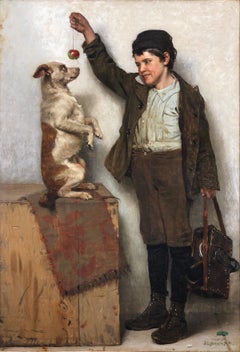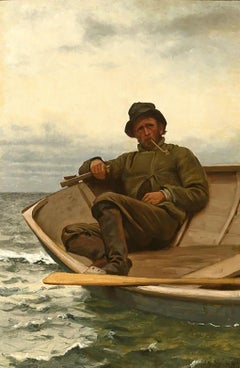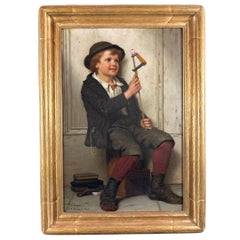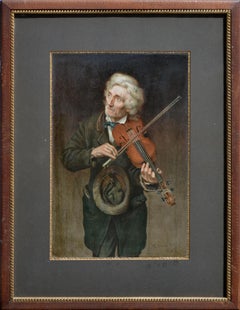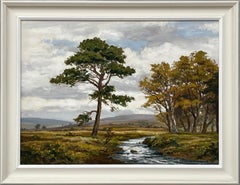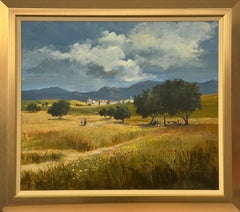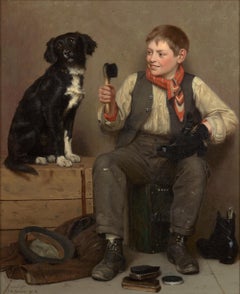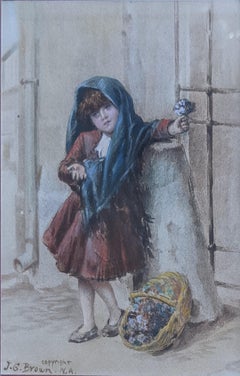John George Brown Art
American, 1831-1913
John George Brown was born in 1831 near Durham, England. At fourteen he began a seven-year apprenticeship as a glass-cutter in Newcastle-on-Tyne, studying at night with William Bell Scott at the School of Design. From 1852 to 18253 he worked at the Holyrood Glass Works, Edinburgh, studying evenings at the Trustees Academy with Robert Scott Lauder. In 1853 Brown spent the summer in London where he painted a few portraits before emigrating to the United States that fall. He settled in Brooklyn finding work at the Brooklyn Flint Glass Company. During this time he attended the free classes offered at the Graham Art School and later studied under Thomas Seir Cummings at the National Academy of Design.
In 1855, Brown opened a studio as a portrait painter. Brown received the support of the art dealer, Samuel S. P. Avery, and John H. Sherwood, collector and builder of the Sherwood Studio Building in 1880, who encouraged his turning from portraits to children as subjects. In 1859 Brown was one of the founding members of the Brooklyn Art Society and in 1861 a founding member of the Brooklyn Art Association. He moved to New York in 1861 finding quarters in the Tenth Street Studio Building where he maintained a studio for the rest of his life. Brown began in 1858 to exhibit at the National Academy, a practice he continued every year, except 1871, until his death. He was elected an associate of the Academy in 1861, full member in 1863, and served as its vice-president from 1899-1904.
After turning to genre scenes of the street children of New York City in the 1860s, he soon became famous and wealthy. Brown copyrighted many of his paintings that were often reproduced commercially as chromolithographs or photographic reproductions. In 1867 he was elected one of the original members of the American Watercolor Society and was its president from 1887-1904. Brown and the art dealer, John Snedecor, travelled to Europe in 1870, visiting both London and Paris. During the summer months, he often explored the rural areas of New York and Vermont, as well as Grand Manan Island in the Bay of Fundy.to
1
1
2
4
1
Overall Width
to
Overall Height
to
8
5
3
8
7
5
3
3
3
2
2
1
1
1
1
1
7
7
6
6
1
8
8,227
2,805
1,654
1,312
5
8
Artist: John George Brown
Preparing the Trick
By John George Brown
Located in Missouri, MO
Canvas Size: approx 26.5 x 18
Framed Size: approx 30 x 22 inches
Born into a poor family in Durham, England, John George Brown (1831-1913) earned a reputation as one of 19th-century...
Category
Late 19th Century American Realist John George Brown Art
Materials
Canvas, Oil
Portrait of Grandmother and Grandson titled "Peeling Apples"
By John George Brown
Located in Fredericksburg, VA
John George Brown (1831–1913) was a prominent British-born American painter, renowned for his genre paintings that vividly depict the everyday life of chi...
Category
Late 19th Century Hudson River School John George Brown Art
Materials
Canvas, Oil
Homeward Bound
By John George Brown
Located in Fort Washington, PA
Signature: Signed Lower Right
Homeward Bound is a product of John George Brown’s 1877 and 1878 trips to Grand Manan Island, off the coast of Maine in t...
Category
1870s John George Brown Art
Materials
Canvas, Oil
The Confab
By John George Brown
Located in Fort Washington, PA
This charming scene of four boys sitting on a bench having a conversation is typical of the sentimentalized portrayals of street urchins that John George Brown...
Category
1880s Realist John George Brown Art
Materials
Canvas, Oil, Board
"A Short Break from Work" Oil On Canvas / Board By John George Brown
By John George Brown
Located in Jacksonville, FL
"A Short Break from Work" captures the essence of a fleeting moment in the life of a young boy, skillfully portrayed by the artist John George Brown in oil on canvas or board. The sc...
Category
19th Century Academic John George Brown Art
Materials
Oil
Old Violinist - Late 19th Century Figurative Lithograph
By John George Brown
Located in Soquel, CA
Finely detailed late 19th century chromo-lithograph portrait of a violinist street musician by John George Brown (British, 1831-1913). Many of Brown’s paintings were reproduced in lithography (Chromo-lithograpy), as is the case with the one offered here. Presented in a rustic antique Oak wood frame with giltwood fillet. Image, 15.63"H x 10.63"W.
John George Brown was a British citizen and an American painter born in Durham, England. His parents apprenticed him to the career of glass worker at the age of fourteen, in an attempt to dissuade him from pursuing painting. He studied nights at the School of Design in Newcastle-on-Tyne while working as a glass cutter there between 1849 and 1852, and evenings at the Trustees Academy in Edinburgh while working at the Holyrood Glass Works between 1852 ad 1853. After moving to New York City in 1853, he studied with Thomas Seir Cummings at the National Academy of Design where he was elected a National Academician in 1861. Brown was the Academy’s vice-president from 1899 to 1904.
Around 1855, he worked for the owner of the Brooklyn Glass Company, and later he married the daughter of his employer. His father-in-law encouraged his artistic abilities, supporting him financially, letting Brown pursue painting full-time. In 1866, he became one of the charter members of the Water-Color Society, of which he was president from 1887 to 1904. Brown became famous for his depictions of street urchins found of the streets of New York (bootblacks, street musicians, posy sellers, newsboys, etc.).
Brown’s art is best characterized as British genre painting...
Category
1870s Realist John George Brown Art
Materials
Paper, Lithograph
$463 Sale Price
20% Off
Oil Portrait of Child and Baby Sisters Playing
By John George Brown
Located in Fredericksburg, VA
This beautiful oil on canvas painting of two sisters playing by the famous American Artist John G Brown has been lined. There is a slight touch up, and i...
Category
Late 19th Century Hudson River School John George Brown Art
Materials
Canvas, Oil
The Monopolist
By John George Brown
Located in Fort Washington, PA
Framed Dimensions: 36.00" x 48.00"
Signature: Signed Lower Right
J.G Brown's "Monopolist" was listed in 1885's Spring Exhibit catalogue of M.A. It was displayed on a panel in The We...
Category
1880s John George Brown Art
Materials
Canvas, Oil
Price Upon Request
Related Items
River Landscape of Glenfinnan in the Scottish Highlands by 20th Century Artist
Located in Preston, GB
Original Oil Painting of River Landscape of Glenfinnan in the Scottish Highlands by 20th Century Artist, Robert Egginton.
Art measures 30 x 22 inches
Frame measures 36 x 28 inches
Presented in the highest quality hand-finished off-white Frinton moulding.
Robert Egginton was born in Devon in 1943 and is a landscape painter in watercolours and oils. He paints mainly Scottish scenes in an accurate pictorial manner, with a bright palette. He is the grandson of Wycliffe Egginton RI (1875-1951) and nephew of Frank Egginton...
Category
Late 20th Century Realist John George Brown Art
Materials
Oil, Canvas, Cotton, Cotton Canvas, Board
$2,657 Sale Price
44% Off
H 28 in W 36 in D 2 in
Cyprus - Landscape Painting of Sun Drenched Eastern Mediterranean Country Scene
By David Mitchell
Located in Preston, GB
Cyprus - Landscape Painting of Sun Drenched Eastern Mediterranean Country Scene by 20th Century Artist, David Mitchell (1936-2020)
Art measures 28 x 24 inches
Frame measures 34 x 3...
Category
Late 20th Century Realist John George Brown Art
Materials
Canvas, Acrylic, Board
$1,468 Sale Price
27% Off
H 30 in W 34 in D 1 in
Sitges beach Barcelona Spain mediterranean seascape oil on canvas painting
By Joan Abello Prat
Located in Barcelona, Barcelona
Title: Playa de Sitges
Artist: Joan Abelló Prat (1922–2008)
Medium: Oil on canvas
Dimensions: 33 x 41 cm (12.99 x 16.14 in)
Framed dimensions: 37 x 45 cm (14.57 x 17.72 in)
Date: 200...
Category
Early 2000s Post-Impressionist John George Brown Art
Materials
Oil, Canvas
Antique American Oil Painting Framed Horse Race Elizabeth Bell Arabian Dappled
Located in Buffalo, NY
Elizabeth Bell’s Dappled Elegance is a masterfully rendered oil painting celebrating the grace and stature of an Arabian or American Saddlebred horse in motion. The artist captures t...
Category
1930s American Realist John George Brown Art
Materials
Canvas, Oil
Virgin Mary and Child Jesus oil on canvas painting
Located in Barcelona, Barcelona
Title: Virgin Mary and Child Jesus
Artist: Francisco Ribera Gómez (1907-1990)
Technique: Oil on canvas
Dimensions: 31.9 x 25.6 inches (unframed)
Date of creation: 1942
Style: Classical Academicism with Renaissance influences
Description of the Artwork
The painting depicts the Virgin Mary holding the Child Jesus in a tender and intimate moment. Warm colors, primarily reds, greens, and soft flesh tones, enhance the devotional nature of the scene. The use of golden halos, symbolizing sanctity, along with serene and realistic expressions, directly connects with the Renaissance pictorial tradition.
The style belongs to classical academicism, characterized by a balanced composition, meticulous drawing, and a masterful use of chiaroscuro to give volume and depth to the figures. The detailed rendering of the flesh tones and draperies amplifies the spirituality and solemnity of the piece, evoking the works of great masters such as Raphael and Murillo.
Artist's Biography
Francisco Ribera Gómez (1907-1990) was a prominent 20th-century Spanish painter known for his depictions of religious scenes, female portraits, and costumbrist works. Trained at the Royal Academy of Fine Arts of San Fernando, Ribera Gómez received numerous accolades and was regarded as one of the great exponents of Spanish academicism. His work combines a rigorous technical foundation with luminous sensitivity and an idealized sense of beauty.
Influences and Comparisons
Francisco Ribera Gómez's work can be compared to other academic and religious artists who share a similar aesthetic:
Bartolomé Esteban Murillo: In the emotional and approachable treatment of religious themes.
William-Adolphe Bouguereau: For the idealization of human figures and technical mastery.
Raphael (Raffaello Sanzio): For harmonious composition and the depiction of the Virgin Mary.
Within the Spanish tradition, his style recalls Eduardo Rosales...
Category
1940s Academic John George Brown Art
Materials
Canvas, Oil
$1,672 Sale Price
43% Off
H 31.89 in W 25.6 in
"Sailing at Dusk" Realist Oil Painting on Canvas Board of Sailboat in Open Sea
By George Nemethy
Located in New York, NY
George Nemethy finds his inspiration in moments of quiet and solitude. Where he finds himself one with the sea and the sky and the tranquil world which he freely escapes to. Trained from an early age by his father Albert Nemethy, a world-renowned painter known best for his large scale steamer boats, George found...
Category
Late 20th Century Realist John George Brown Art
Materials
Canvas, Oil, Board
$6,000
H 6.75 in W 6.75 in D 1 in
surreal scene oil on canvas painting surrealism
Located in Barcelona, Barcelona
Francesc Gironés (1904-1997) - Surrealist scene - Oil canvas
Oil measures 38x46 cm.
Frame measures 47x55 cm.
Francesc Gironés was a painter from Poblenou about whom little is known,...
Category
1980s Surrealist John George Brown Art
Materials
Canvas, Oil
"Tranquil Sailing" Realist Oil Painting on Canvas Board of Sailboat in Open Sea
By George Nemethy
Located in New York, NY
George Nemethy finds his inspiration in moments of quiet and solitude. Where he finds himself one with the sea and the sky and the tranquil world which he freely escapes to. Trained from an early age by his father Albert Nemethy, a world-renowned painter known best for his large scale steamer boats, George found...
Category
Late 20th Century Realist John George Brown Art
Materials
Canvas, Oil, Board
$7,200
H 11.5 in W 11 in D 0.75 in
"Nude" Marguerite Stuber Pearson, Female Nude, Outdoor Boston School, American
By Marguerite Stuber Pearson
Located in New York, NY
Marguerite Stuber Pearson
Nude, circa 1940
Signed lower right
Oil on artist board
20 x 16 inches
Marguerite Stuber Pearson was an American painter best known for her elegant portra...
Category
1940s Academic John George Brown Art
Materials
Oil, Board
Afghan Girl iconic poster: Sharbat Gula, Pakistan (Hand Signed by Steve McCurry)
By Steve McCurry
Located in New York, NY
Steve McCurry
Sharbat Gula, Afghan Girl, Pakistan (Hand Signed), 1984
Offset Lithograph poster
Hand signed by the photographer in black felt pen on the front
24 × 20 inches
Unframed...
Category
1980s Realist John George Brown Art
Materials
Felt Pen, Lithograph, Offset
Mother & Child at a Beach on West Coast of Ireland by 20th Century Irish Artist
By Manson Blair
Located in Preston, GB
Mother & Child at a Beach on the West Coast of Ireland by 20th Century Irish Artist, Manson Blair. Presented in a high quality vintage gold frame with gre...
Category
Late 20th Century Realist John George Brown Art
Materials
Oil, Board, Paint, Canvas, Glass
$1,146 Sale Price
34% Off
H 16 in W 20 in D 3 in
Little Chinese Girl
By Ming Wai
Located in San Francisco, CA
This artwork "Little Chinese Girl" 1982 in a color off set lithograph by renown Chinese/American artist Wai Ming A.K.A Lo Hing Kwok, b.1938. It is hand signed an inscribed A.C (Hors Commerce) in pencil by the artist. The image size is 24.5 x 22 inches, sheet size is 28 x 24.5 inches. It is in excellent condition, has never been framed.
About the artist:
Wai Ming, was born in Canton, South China on November 11, 1938, the son of a school master with nine children. Extremely poor as a child, he was raised in Hong Kong enduring many hardships amidst a chaotic environment of war and refugee settlements. Wai Ming's love for art flourished and he developed his drawing techniques without any art education, just painting what he saw. In the 1960s, Ming found representation in Hong Kong and also took the unusual step of opening his own gallery to display his work in. His primary interest being to capture images of life in fishing villages, or 'fish-folk', who have retained traditional Chinese culture, his work was at home with the sensibilities of many art buyers in Hong Kong. Crossing the ocean in his mid-30s, Wai Ming arrived in San Francisco from Hong Kong in 1974. There, he experienced initial resistance from galleries and the official art world for a variety of reasons, but was ultimately embraced by dealer Jack Swanson...
Category
Late 20th Century Realist John George Brown Art
Materials
Lithograph
Previously Available Items
Only A Nickel, Joe by John George Brown
By John George Brown
Located in New Orleans, LA
John George Brown
1831-1913 British-American
Only A Nickel, Joe
Signed "Copyright / J.G. Brown N.A." (lower left)
Oil on canvas
A young shoeshine boy ...
Category
20th Century Realist John George Brown Art
Materials
Canvas, Oil
"Flower Girl, " John George Brown, Genre Painting, Street Figure
By John George Brown
Located in New York, NY
John George Brown (1831 - 1913)
Flower Girl, circa 1900
Watercolor on paper
6 3/4 x 4 3/4 inches
Signed lower left
Period Hand Carved Foster Brothers Fram...
Category
Early 1900s Ashcan School John George Brown Art
Materials
Paper, Watercolor
Something to See
By John George Brown
Located in New Orleans, LA
A young girl and boy are the subject of this oil on canvas by John George Brown, one of the most successful genre painters of the late 19th century. The artist possessed a particula...
Category
19th Century Realist John George Brown Art
Materials
Canvas, Oil
Young Girl in the Woods
By John George Brown
Located in Milford, NH
A fine watercolor of a young girl in the woods surrounded by flowers by British American artist John George Brown (1831-1913). Brown was born in Dur...
Category
Late 19th Century Impressionist John George Brown Art
Materials
Paper, Watercolor
Lookey There!
By John George Brown
Located in Missouri, MO
John George Brown
"Lookey There!" 1905
Oil on Canvas
Signed and Dated Lower Right
Site: approx 24 x 17 inches
Framed: approx 30 x 24 inches
Born into a poor family in Durh...
Category
Early 1900s Realist John George Brown Art
Materials
Canvas, Oil
John George Brown art for sale on 1stDibs.
Find a wide variety of authentic John George Brown art available for sale on 1stDibs. You can also browse by medium to find art by John George Brown in paint, oil paint, canvas and more. Much of the original work by this artist or collective was created during the 19th century and is mostly associated with the Impressionist style. Not every interior allows for large John George Brown art, so small editions measuring 10 inches across are available. Customers who are interested in this artist might also find the work of Jove Wang, Peter Poskas, and Eduardo Leon Garrido. John George Brown art prices can differ depending upon medium, time period and other attributes. On 1stDibs, the price for these items starts at $463 and tops out at $315,000, while the average work can sell for $22,000.
